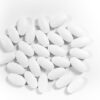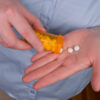As a personal trainer, I come into contact with young men who appear to be on anabolic steroids, typically taken to increase muscle mass and improve athletic performance. What are the signs they are using steroids and how anabolic steroids affect teens? For starters, they exhibit muscle mass that seems to be beyond “normal,” and they exhibit aggressive behavior. Other signs of steroid use in boys include:
- Acne
- Stunted growth
- Accelerated puberty
- Shrinking of the testicles
- Development of breasts
- Bruising or Marks From Injection Sites (Shoulders, Thighs, Buttocks etc.)
(See our Steroids resource guide for a complete guide.)
Browse This Article
How do anabolic steroids affect teens?
But steroid use isn’t just for men. It’s on the rise among girls and young women, as well, says Scott Weiss, DPT, owner of Bodhizone Physical Therapy and Wellness in New York City.
“It’s on the rise in girls between 18-20 years old,” he says. “And about two percent [of girls] in any given high school [have tried steroids], but this is still lower than their male counterparts. Female signs of steroid use include changes in or cessation of the menstrual cycle, enlargement of the clitoris and a permanently deepened voice,” notes Weiss. Girls can also experience excessive body hair and male-pattern baldness.
How Can You Tell?
 Some of the signs of steroid use mimic typical adolescence, especially in boys, such as acne, moodiness, and increased muscle mass. How can a parent tell the difference between normal developmental changes and signs of steroid use?
Some of the signs of steroid use mimic typical adolescence, especially in boys, such as acne, moodiness, and increased muscle mass. How can a parent tell the difference between normal developmental changes and signs of steroid use?
The speed at which these changes are occurring, says Weiss, is a big clue for parents. “Vertical growth can take place over a summer,” he explains, “but muscular growth takes years. Acne can greatly worsen and occur in more places on the body. Stretch marks may appear from the sudden muscle growth, especially across the chest and hips. The mood swings can be violent and they are the aggressor in many altercations. And obviously hair loss is not normal during puberty.”
Longer term effects of anabolic steroid use include shortened stature, tendon rupture (from the sudden muscular growth), liver cancer and hepatitis, infertility, and cardiovascular problems, including higher LDL (bad) cholesterol, lower HDL (good) cholesterol, high blood pressure, and even heart attack. One recent study showed that anabolic steroids weaken the heart even more than previously thought. So ironically, while steroids are taken to increase muscle mass and strength, they actually weaken the most important muscle in the body.
Anabolic steroids differ from corticosteroids, often given for conditions such as asthma and allergies. “Corticosteroids are medications that have effects on inflammation in the body,” explains Shannon Safier MD, Assistant Professor of Orthopedic Surgery and Pediatrics, and Director of Sports Medicine at St. Christopher’s Hospital for Children in Philadelphia. “They are often used to reduce inflammation. Corticosteroids can be immunosuppressive and decrease the activity of the immune system, as well.”
How Common Is Steroid Use?
Statistics vary in use of steroid in teens among all populations. This is in part due to the fact that anabolic steroids are not commonly included when participants are surveyed about drug abuse. However, a study published by the United States Sports Academy (USSA) concludes that “approximately one percent of 10- to 14-year-old youth sports participants are using or have used anabolic steroids. Even though usage has decreased by over 50 percent since 1989, steroid use is still a serious problem.”
In addition, the 2005 Monitoring the Future study of drug use among adolescents in middle and high schools across the United States that was funded by the National Institute on Drug Abuse (NIDA) reported that “among 12th-graders, from 2000 to 2004, past year steroid use increased, but in 2005 there was a significant decrease, from 2.5 percent to 1.5 percent.” In a similar 2012 NIDA-funded study teens were asked if they ever tried steroids—even once: 1.2 percent of 8th graders, 1.3 percent of 10th graders, and 1.8 percent of 12th graders reported they had tried steroids at least once. Other studies show similar results, while a University of Minnesota study showed a higher incidence of steroid use: out of 2,793 students surveyed with an average age around 14, 5.9 percent had used steroids.
While data may conflict, trends do tend to go up and down. One thing that has been shown to aid in the down trend is education. According to the USSA study, “less than two-thirds of the athletes had the effects of anabolic steroids explained to them, and less than half of them have received their knowledge from an adult (parent, coach, teacher, athletic trainer, etc.).”
The NIDA study found that simply giving students information about how anabolic steroids affect teens is not enough to convince them to avoid the drugs. “Presenting both the risks and benefits of anabolic steroid use is more effective in convincing adolescents about steroids’ negative effects, apparently because the students find a balanced approach more credible.” This makes sense. When you tell a teen to avoid something, what is he or she likely to do?
Which Teens Are Drawn to Steroids?
As with any other drug, there is a certain population that is more likely to abuse anabolic steroids. “Teen boys who are feeling vulnerable or inadequate to cope with the demands of teen life are more likely to use steroids to try to make themselves look and feel more powerful,” explains Carole Lieberman, MD, Beverly Hills psychiatrist and author. “This includes teen boys who are being bullied, abused or rejected by teen girls.”
A study in the Journal of Adolescent Health echoes this assessment: “In males, steroid use was associated with poorer self-esteem and higher rates of depressed mood and attempted suicide, poorer knowledge and attitudes about health, greater participation in sports that emphasize weight and shape, greater parental concern about weight, and higher rates of disordered eating and substance use. Among females, steroid use was less consistent in its associations with other variables, although overall, a similar pattern of results emerged.”
If you suspect your teen may be using anabolic steroids, a trip to the doctor is in order, notes Dr. Lieberman. “Parents can bring their teen in to their family doctor for a blood or urine test to look for steroids,” she says. “Most importantly, if parents suspect their teens may be using steroids, they should bring them to a psychiatrist for an evaluation, because even if the teen is not actually using steroids, the behavior that became worrisome to the parent needs an evaluation. Whether it is teen rebellion or maladjustment or the beginnings of a mental illness, the teen needs help.”
There are also home urine tests that will detect many of the common anabolic steroids used today, and these can be found online or at your community drug store.
If you have any concerns that your teen may be using anabolic steroids, experts recommend that you have an honest conversation with your child and provide the information and support her or she needs.
Sources
Anabolic Steroid Abuse (National Institute on Drug Abuse)
Anabolic Steroids and Pre-Adolescent Athletes: Prevalence, Knowledge, and Attitudes (United States Sports Academy, The Sport Journal)
Steroid use among adolescents: findings from Project EAT (PubMed.gov, National Institutes of Health)
Anabolic Androgenic Steroid Use in Teens: Prevalence, Demographics and Perception of Effects (Journal of Child & Adolescent Substance Abuse, Volume 20, Issue 4, 2011)
Good Source for Your Teens
Drug facts: Anabolic Steroids NIDA for Teens, National Institute on Drug Abuse







